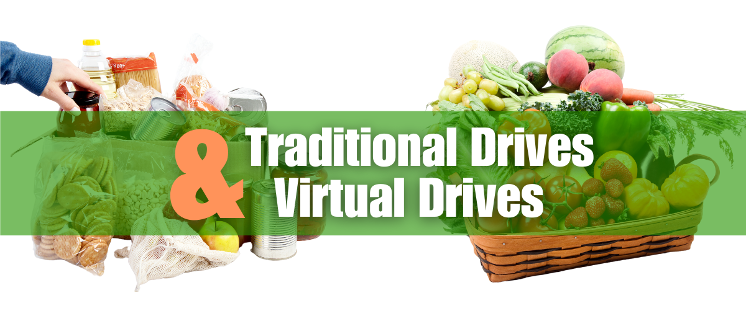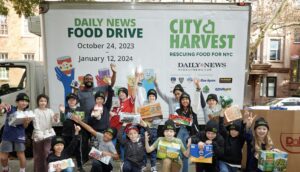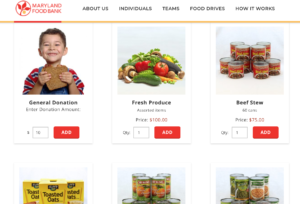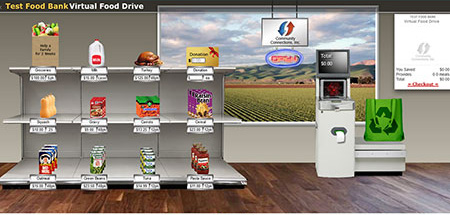
Welcome to the
Food Drive Resource Hub
Sponsored by #GiveHealthy
Ignite the Most Popular Form of Giving
Our Food Drive Resource Hub aims to help food banks take advantage of the massive inclination among Americans to give generously when it comes to food. The hub offers insights on how to maximize traditional food drive efforts, like Arkansas Food Bank does with its summer cereal drive. It also looks at new virtual food-drive technology that lets food banks strategically incorporate food drives into an overall food-sourcing plan, like City Harvest does with its wide-ranging approach. Check out the buttons above to navigate around the hub.

“Food drives are a really critical link between the food bank and the community”
Paule Pachter, Chief Executive Officer at Long Island Cares
Sponsored Content
See how #GiveHealthy helps get the food you want delivered where and when you want it.
Case Studies
- City Harvest Takes a Big Swing at Food DrivesCity Harvest’s approach to food drives is to cast a wide net. The New York City-based food bank – one of the largest in the country – sees food drives as an effective way for everyday New Yorkers to get engaged with its mission to end hunger in NYC. So…
- Summer Food Drives Can Pack a PunchWhile some food banks have downplayed traditional food drives in recent years, others have found that a combination of engagement, community, and collaboration has made their traditional food drives incredibly successful. Gleaners Community Food Bank, which serves five counties in southeast Michigan, hosts a trio of food drives each summer.…
- How Food Drives are Getting HealthierWhen Greater Vancouver Food Bank decided to do away with traditional food drives, it was perfectly clear about why. It proclaimed on social media and its website that up to 30% of the food it received from food drives was spoiled, damaged or unsafe to eat. In addition, it said,…
- How a Virtual Food Drive Went ViralThere may be no better case study demonstrating the power of virtual food drives than what happened at Long Island Cares. When Covid-19 first hit, the Hauppauge, N.Y.-based food bank cancelled all of its spring food drives and quickly pivoted to its existing partnership with YouGiveGoods, a N.J.-based provider of…
- Virtual Food Drives Gain Traction as Covid-19 ResponseWhen the Stamp Out Hunger food drive, usually held the second Saturday in May, was postponed because of Covid-19, it was the largest food drive in the country to be suspended, but far from the only. The shuttering of the Stamp Out Hunger drive, organized annually by the National Association…
- Food Drives Get a Makeover with #GiveHealthyIt’s fair to say that food banks have a bit of a love-hate relationship with food drives. While they are great for engaging the community and bringing in much-needed food, they are less cost-efficient than cash and can generate heaps of work on the back end in terms of checking…
Best Practices
Have a strategy
It’s important to have clear reasons for doing food drives, and a big one is to raise awareness about food insecurity, says Casey Castillo, CEO of San Diego Food Bank. “We often get caught up in counting pounds or counting dollars,” he said. “But one of our key responsibilities as a food bank is raising awareness.”
Consider a pet food drive
Long Island Cares enlists two to three dozen local legislators to host pet-food drives at their district offices. “They publicize it incredibly in the local papers and we end up with 40,000 to 50,000 pounds of pet food,” says Paule Pachter, CEO
Direct the food to pantry partners
Feeding America of Riverside and San Bernardino Counties rarely takes food-drive food into its warehouse, instead directing it to partner agencies that report the poundage. “It makes it easier for us,” said Carolyn Solar, CEO. “We never have to go through that process of actually sorting it.”
Talk about the environment
One benefit of a virtual food drive that raises cash is that it eliminates all the logistics and expense of transporting food, which is appealing to donors interested in sustainability. “We live in a dense urban county, so people have responded well to the environmental piece” of virtual food drives, said Allison Pratt, Chief of Partnerships and Strategy at Alameda County Community Food Bank
Do a “real food” virtual food drive
Virtual food drives that raise funds were a problem for Feeding America of Riverside and San Bernardino Counties because of some corporations that prohibited their employees from donating cash. For those situations, Carolyn Solar, CEO, encouraged the #GiveHealthy platform, a virtual food drive that raises actual food, not cash. The platform also resolved issues related to storing or transporting food. “I would always push #GiveHealthy because it was just easy,” Solar said.
Food Drive Resources We Love
Community Food Bank of New Jersey has a Period Equity Kit aimed at addressing period poverty, which impacts two in five Americans.
This toolkit from Second Harvest Food Bank of Central Florida includes the “quirky” messages that community fundraiser Courtney used to inspire donors to contribute to her drive.
North Texas Food Bank’s food drive toolkit has actual photos of most needed items.
A simple graphic from San Antonio Food Bank identifies its “12 Most Wanted Items.”
St. Louis Area Foodbank’s food drive toolkit includes a QR code that directs people to current food drive campaigns happening on its website.
New Hampshire Food Bank has a “Food of the Month” and cheery flyers that can be downloaded for every month.
Maryland Food Bank’s attractive toolkit includes suggestions for creative food-drive themes, like Two for Two Tuesdays (bring two cans of food and $2).
Arkansas Foodbank’s Summer Cereal Drive Playbook includes a note from Claire, the food bank’s Community Development Coordinator, as well as fun fundraising ideas, like “Run the Reverend Out of His Office” by storing all the donated boxes of cereal there. (See more on Arkansas Foodbank’s Summer Cereal Drive here.)
Find Food Bank uses the MyPlate Guidelines to emphasize healthy foods in its food drive flyer.
Directory
#GiveHealthy wants to shift the nature of food drives by making it easy for people to donate food that is fresh and healthy, rather than canned. A wedding-registry style format lets donors choose the healthy food they would like to donate. The fresh food gets delivered free of charge to the food bank and/or its partners.
Cost: FREE
Contact: Nora Noll, Team Leader
800-418-1164
Designed to look like a grocery store, the software lets donors select grocery items from shelves and run them through a virtual cash register that adds up their value. Donors contribute the equivalent cash amount.
Cost: custom pricing
Contact: support@fooddriveonline.org
Classy, a Go Fund Me company, offers peer-to-peer fundraising software that lets people create or contribute to fund drives that raise cash. Food banks can customize the look of their online fundraising page, and the software displays top fundraising individuals and teams.
Cost: custom pricing
Contact: requires a demo
Qgiv offers peer-to-peer fundraising software that lets users create virtual fund drives using drag-and-drop tools. The software, which offers leaderboards, activity trackers and goal thermometers, is designed to raise cash.
Cost: $ 259/month or $ 695/quarter
Contact: 888-855-9595
You Give Goods hosts a wide range of drives on its website, including virtual food drives on behalf of food banks. The drives let donors pick healthy food items that get delivered at no charge to the food bank.
Cost: FREE
Contact: 877-526-4483










